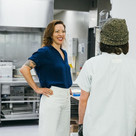Table of contents
Efficiently training new hires is integral to saving time and driving your business’s success. According to a 2021 Work Institute report, 33.7% of employees who leave jobs will do so during their first year. This turnover creates a challenging environment for business owners and managers. They end up spending resources onboarding new talent and missing opportunities to maximize employee contributions.
By implementing clear, impactful training methods, you can set up new hires to succeed. According to a 2020 survey by Indeed, 39% of people who left their jobs within six months said that better training would likely have led them to stay. That higher retention can lead to greater output and happier employees.
How to turn new hires into productive employees
Managers have been trying to identify the best methods to train employees for as long as work has existed. As the nature of work and technology change, so too does training. However, certain concepts remain true and can guide your training, regardless of your industry.
In a 2005 management review for MIT Sloan, training methods are classified into one of two categories:
- Informational: This is how most companies design training. This approach provides new hires with all the information they need about the company and their role. It then trusts the new hires to use this information to figure out how best to do their jobs.
- Relational: This approach focuses less on specifics and more on people. Emphasis is placed on meeting your new co-workers and letting them guide you as you learn your new position.
Out of these two approaches, relational was shown to be more effective at bringing people up to speed quickly. Trainees could digest information at their own pace and rely on trusted colleagues when they had questions.
The review then went further by identifying five major issues that lessened the effectiveness of training:
- Companies assume the best employees can figure things out on their own. New hires know this and become reluctant to ask questions in an attempt to prove their competence.
- New hires are often given too much information at once. The intention is to give them everything they need to succeed but it becomes overwhelming.
- Not enough time is spent introducing people to their new colleagues. Instead, quick introductions take the place of meaningful relationship building.
- New hires are often given “easy” tasks so they can experience early success. This can ingrain poor work habits and lead to false expectations about the work.
- Mentors are often assigned to new employees. This leads to a dynamic where new hires feel uncomfortable asking questions of someone they see as a mentor. This relationship works better if mentors are replaced by “buddies” who new hires feel more comfortable with.
With these potential pitfalls in mind, you can develop your training. There are three categories to focus on: onboarding, technical skills, and soft skills.
Onboarding best strategies
Onboarding, where you have new hires fill out all necessary paperwork, is important for business purposes but doesn’t have much of an effect on performance. As such, being able to accomplish onboarding quickly allows you to focus your efforts on more important elements of training. Tips include:
- Have an efficient system in place. Creating an onboarding checklist can be helpful.
- Use automation tools to speed up the process. In a Forbes survey of HR experts, these tools were identified as keys to streamlining the onboarding process.
- Use remote self-onboarding or employer onboarding tools so you can handle everything ahead of in-person training. Easy-to-use systems like Square Payroll allow new employees to quickly create an account and hit the ground running.
- Invest in intuitive POS solutions and more business tools that are easy for employee onboarding.
- Embrace tools such as Square Team Communication, which provides instant messaging and knowledge sharing to help your employees work smarter and thrive together.
Looking for HR resources? Square HR Experts helps you save time and money with customizable HR document templates, an employee handbook builder, and access to certified HR experts. HR Experts also helps you avoid costly compliance penalties with proactive alerts when employment laws are released or updated.
Technical skills best strategies
Technical training includes teaching new employees all of your internal systems, such as your POS. To best do this, remember that different people have different learning styles. Business News Daily breaks these styles into three categories:
- Visual: Learning by watching someone else perform a task.
- Repetition: Learning by repeatedly doing something by yourself and adjusting to any mistakes.
- Reading: Learning by studying a guide or manual.
The best training will implement all of these learning styles. You can also look at restaurants for examples of technical training, as even experienced servers need to learn new menus. This can be accomplished with a mix of all three learning styles:
- Explain menu items to new servers. Also, let them see and taste items.
- Allow new servers to take orders with support from a trainer. This helps them identify and answer typical menu-based questions.
- Provide copies of the menu and ingredient lists for take-home study.
Tests can also be used to aid learning. However, a 2018 meta-analysis shows that not all forms of learning are equally enhanced by testing. Testing is a useful tool but shouldn’t be overly relied upon. The National Federation of Independent Business may have the best advice: Focus on slow, flexible training that can be adjusted to suit each trainee.
Soft skills best strategies
Beyond technical systems, new employees also need to learn about your company so they can feel like a part of the team. A Gallup poll showed that attrition can be significantly lowered by communicating a strong company culture. Developing your company culture will lead to happier, more loyal employees.
We can again look at restaurants. Rather than simply training a server in their job, carve out time for them to shadow different employees:
- Kitchen staff
- Food runners
- Bussers
- Bartenders
- Hosts
- Managers
By understanding how the entire restaurant runs, they will understand the company better. Also, by giving new hires time with different trainers you give them a chance to start forming co-worker relationships that will help them as they grow.
Collaborative design
Understanding your goals is the first step to designing an effective training program. Don’t be afraid to talk to your current staff and see what worked and didn’t during their training. This collaboration can help your training be as effective as possible today and into the future.
![]()











